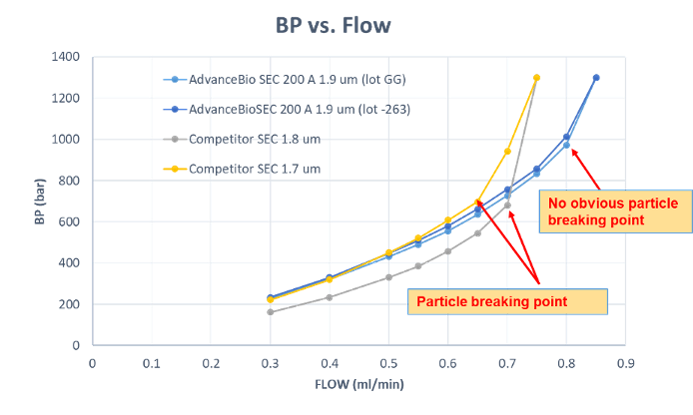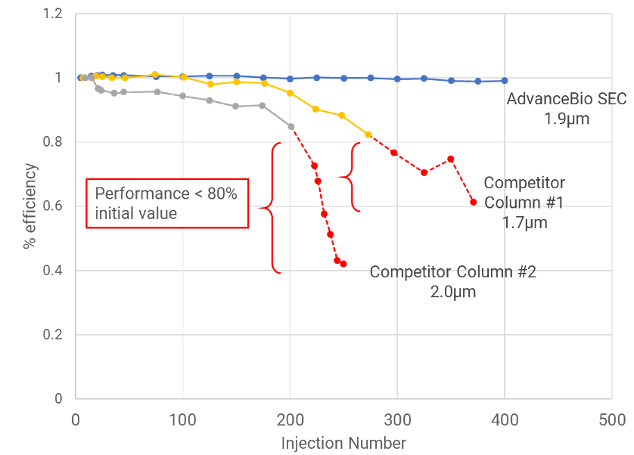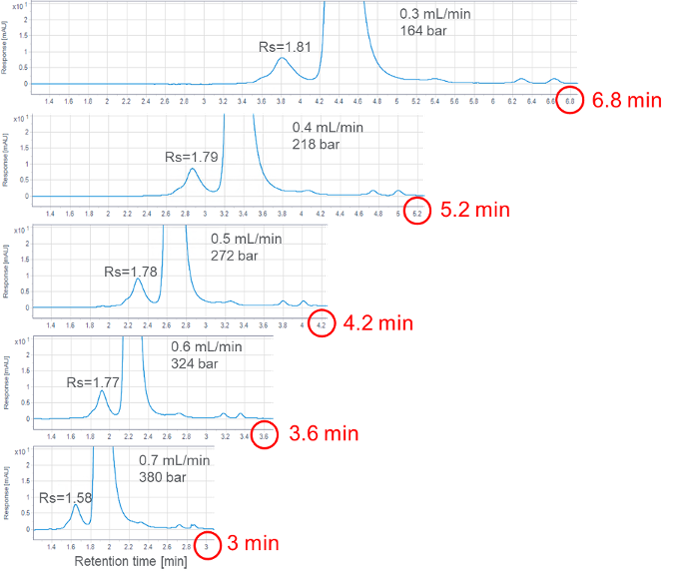In the previous blog post, we discussed how pore size affect SEC performance. In summary, for high resolution and fast separation of biomolecules such as mAbs and their aggregates, the silica particles should exhibit
- The right pore size, with narrow pore size distribution
- Maximum pore volume
- Small particles, such as sub-2 µm particles
SEC columns with sub-2 µm provide the best resolution for mAbs. In this post, we will discuss the importance of particle strength of sub-2 µm particles for SEC columns. Of all attributes of sub-2 µm SEC particles, users may find that the biggest limitation compared to larger particle sizes is the low mechanical strength. SEC particles are typically weaker than other chromatographic media with similar particle size, due to their large pore volume, and this problem is magnified several-fold for sub-2 µm SEC particles. The complaint we’ve heard most frequently from users of SEC columns with sub-2 µm particles is the short lifetime, which is related to particle strength.
We developed a method to test the particle strength. The sub-2 µm particles in MeOH slurry were loaded into a short, 2.1 x 50 mm column at 0.3 mL/min. The flow rate was then gradually increased. Figure below shows curves of backpressure vs. flow rate of our AdvanceBio SEC and other SEC columns in the market. Column pressure would increase almost proportionally to flow rate. But when the particles break, the pressure will increase dramatically. From the figure, we can see the particle breaking point pressure; the competitors' particles break at around 650–700 bar, while AdvanceBio SEC 200Å, 1.9 µm particles have no obvious breaking point up to 1000 bar. Columns must be packed a few hundred bar above their operating pressure for them to be stable and reproducible (so, stable particles at 1000 bar still doesn’t mean the column can be used at 1000 bar).
Particle strength is a very important factor for column lifetime. A 4.6 x 300 mm SEC column of sub-2 µm particles has backpressure around 400 bar. Stronger particles allow us to load the columns at much higher pressure. Our AdvanceBio SEC 200 Å 1.9 µm column has a pressure limit of 620 bar, while other BioSEC columns usually have a pressure limit below 500 bar. We developed a “stop and run” method for lifetime test, in which the pump was stopped and then resumed every 50 injections. This is much closer to how many people use SEC columns – running batches of samples and then stopping for a few days. Based on our test, the other SEC columns after 200–300 injections under normal flow rate of 0.35 mL/min lost more than 20% efficiency, while our AdvanceBio SEC 200 Å 1.9 µm column lasted more than 400 injections.
Another big advantage of strong particles is for fast separation. With strong particles of AdvanceBio SEC 200 Å 1.9 µm, we are able to run at much higher flow rate for fast separation of mAbs, fully utilizing sub-2 µm particle potentials. Figure below shows an example of a baseline separation of Sigma mAb and its dimer in 3 minutes by an AdvanceBio SEC 200 Å 1.9 µm, 4.6 x 150 mm column by increasing flow rate from typical 0.3 mL/min to 0.7 mL/min.
In summary, particle strength is very important for SEC. Stronger particles improve SEC column lifetime and make fast separation feasible for sub-2 µm particles.
Keywords: mAb, monoclonal antibody, ADC, antibody drug conjugates, SEC, size exclusion chromatography, biologics, biosimilars, insulin, molecular weight, aggregation, fragment, quality control, biopharmaceutical, CQA, critical quality attributes, pore size, AdvanceBio, column lifetime



